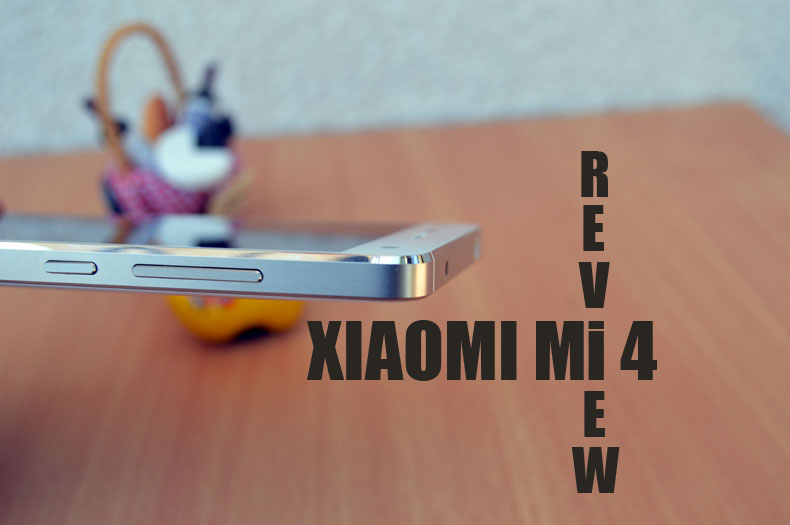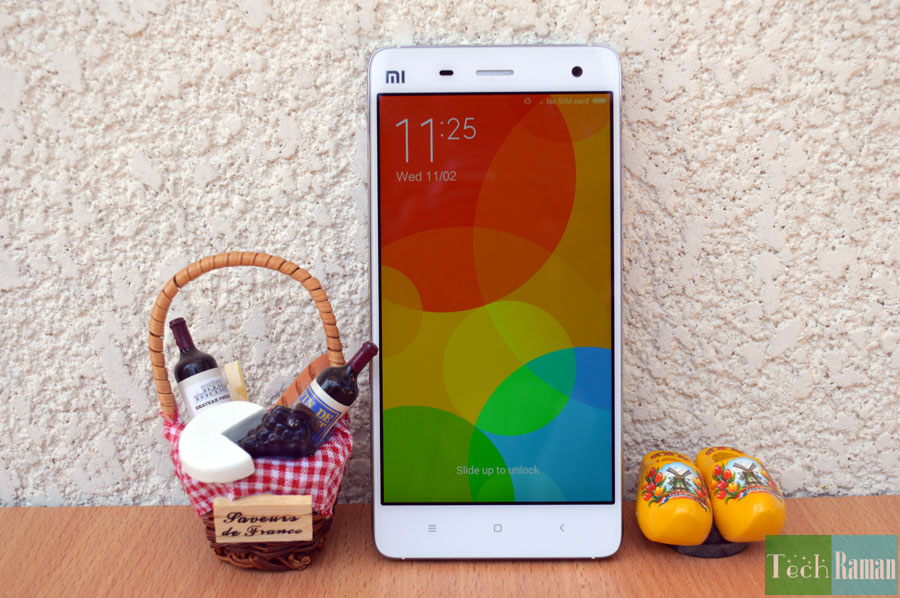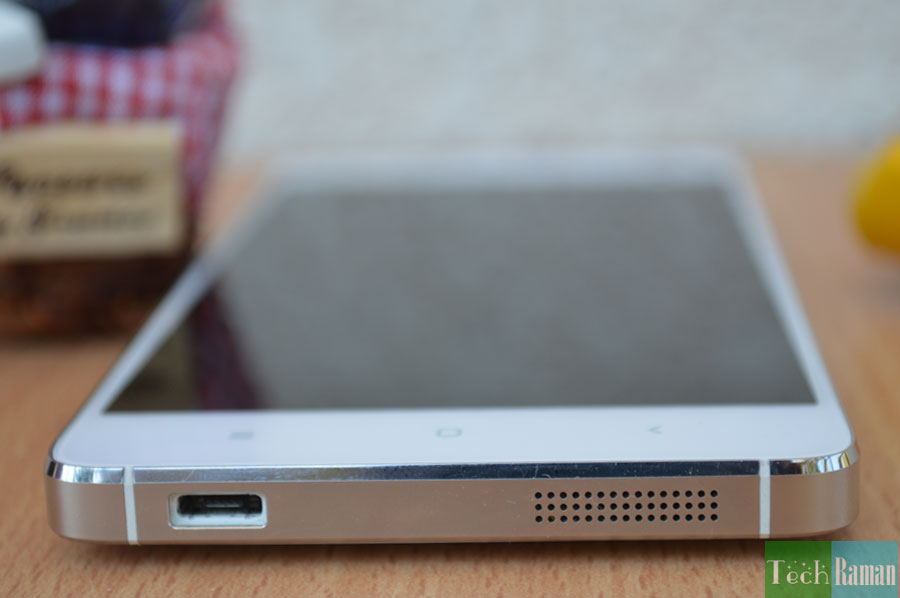
We are not going to bicker over comparison with Apple’s iPhone design because Xiaomi Mi4 stands tall on its own due to a heady mix of fine craftsmanship, powerful hardware and an outstanding UI. Before we dive into our complete take down on the flagship device from the Chinese super star(t up), here is a quick bullets of the specifications.
- 5″ IPS LCD display
- 1080 x 1920 pixels, 441 ppi
- Qualcomm MSM8974AC Snapdragon 801 Chipset
- Quad-core 2.5 GHz Krait 400
- Adreno 330 GPU
- MIUI 6
- 3GB RAM
- 16GB / 64GB
- 13MP rear / 8MP front camera
- 3080 mAh battery
Design, Build quality and Specs
 Xiaomi has taken a giant stride when it comes to design and build quality of Mi4. Not that Mi3 was anything inferior, in fact even now, I quiet liked Mi3 which was more unique-looking. But here with, Mi4, they have stressed upon the build quality which Hugo Barra passionately talked about during one of the interactions.
http://youtu.be/yxx_KvAinK4
The stainless steel banding around the sides and a quick glance at the well chiseled out speaker grille, not to forget the skillfully chamfered edges speaks volumes about the brilliant build quality of Mi4.
Xiaomi has taken a giant stride when it comes to design and build quality of Mi4. Not that Mi3 was anything inferior, in fact even now, I quiet liked Mi3 which was more unique-looking. But here with, Mi4, they have stressed upon the build quality which Hugo Barra passionately talked about during one of the interactions.
http://youtu.be/yxx_KvAinK4
The stainless steel banding around the sides and a quick glance at the well chiseled out speaker grille, not to forget the skillfully chamfered edges speaks volumes about the brilliant build quality of Mi4.
 [gallery link="file" columns="5" ids="8552,8553,8554,8555,8556"]
While the metallic frame and finish piqued my interest, the rear was unimpressive. The glossy back plate is made of plastic but a good one at that wit diamond-like texture to it, the design is generic. It has a curved, soft edges which is definitely ergonomic and cozies the palm but nothing spectacular in design.
The power and volume rockers are on the right and are easier to reach, on the left we find the SIM tray nicely carved on to the metallic side panel and it can be ejected with a pin that is included in the box. The bottom houses the speaker grille and the microUSB port, while on the top sits the 3.5mm audio jack and IR blaster. The Mi logo is seen on the top left, flanked by a sensors, earpiece and the front camera. The back again has the traditional ‘Mi’ logo on the bottom half and the 13MP rear camera with LED flash pecked a little below on the top.
Mi4 showcases a 5-inch, 1080 x 1920 pixel resolution (441 ppi) IPS panels made by JDI (a joint venture between Sony, Toshiba, and Hitachi). It’s an attractive, bright, vibrant and lively. The outdoor visibility is also very good.
The phone is powered by Qualcomm’s Snapdragon 801 processor, clocked at 2.5GHz which is a full blown high-end flagship material. Other healthy inclusions are 3GB RAM, Adreno 330 GPU. While Xiaomi has both 16GB and 64GB onboard storage, the company has outed the 16GB variant with the promise of bringing the 64GB pretty soon. Since there is no option for external storage, you might have to take in account the storage factor if you are buying.
The phone comes with a 3,080mAh battery, I was told that you can manage to take out the back panel using a suction cup, but even if you manage you will only longingly look at the battery which is non-removable.
For a flagship device, it is a big disappointment that there is no LTE. With 4G gaining traction, this is a shame that a crowned jewel should come without it.
[gallery link="file" columns="5" ids="8552,8553,8554,8555,8556"]
While the metallic frame and finish piqued my interest, the rear was unimpressive. The glossy back plate is made of plastic but a good one at that wit diamond-like texture to it, the design is generic. It has a curved, soft edges which is definitely ergonomic and cozies the palm but nothing spectacular in design.
The power and volume rockers are on the right and are easier to reach, on the left we find the SIM tray nicely carved on to the metallic side panel and it can be ejected with a pin that is included in the box. The bottom houses the speaker grille and the microUSB port, while on the top sits the 3.5mm audio jack and IR blaster. The Mi logo is seen on the top left, flanked by a sensors, earpiece and the front camera. The back again has the traditional ‘Mi’ logo on the bottom half and the 13MP rear camera with LED flash pecked a little below on the top.
Mi4 showcases a 5-inch, 1080 x 1920 pixel resolution (441 ppi) IPS panels made by JDI (a joint venture between Sony, Toshiba, and Hitachi). It’s an attractive, bright, vibrant and lively. The outdoor visibility is also very good.
The phone is powered by Qualcomm’s Snapdragon 801 processor, clocked at 2.5GHz which is a full blown high-end flagship material. Other healthy inclusions are 3GB RAM, Adreno 330 GPU. While Xiaomi has both 16GB and 64GB onboard storage, the company has outed the 16GB variant with the promise of bringing the 64GB pretty soon. Since there is no option for external storage, you might have to take in account the storage factor if you are buying.
The phone comes with a 3,080mAh battery, I was told that you can manage to take out the back panel using a suction cup, but even if you manage you will only longingly look at the battery which is non-removable.
For a flagship device, it is a big disappointment that there is no LTE. With 4G gaining traction, this is a shame that a crowned jewel should come without it.
Software: MIUI 6 – the magic pill
The Mi4 runs on Android 4.4.4 KitKat with MIUI treatment. For those used to stock Android experience, initial hands-on the the Xiaomi custom interface might be overwhelming. There are a long list of features you don’t normally see on Android. Xiaomi likes to boast themselves to be a software company first and it is quiet evident in the MIUI, which is easily one of the best custom Android skin out there. MIUI 6 has a flat design with shades of the material design that Google espouses and is extremely colorful. One of my favourite part of the MIUI is the themes section. There are thousands of themes to choose from, including country-specific themes and I love the India specific themes. The themes are not just superficial but changes the entire look and feel of the Mi Smartphones from the ground-up. The charm of the MIUI lies in its feature-rich tweaks and tricks. It offers users to customize the phone that is not possible with the stock android.
From customizing the long press action of the three capacitive buttons to locking individual apps in the recent app trays, the options galore including block list feature for contacts, guest mode, changing notifications light, customizing lock screen, screen gestures and more. And, then you can also easily switch on the torch right from the lock screen which I quiet like in all the Mi phones. In-built apps like Calculator, Calendar, Compass, Clock, Weather, Recorder and others have gotten a new look too in the version 6 of the UI. The Mi 4 has no dedicated “gloves mode” but instead, it will always register your touches even if you’re gloved. Neat.
The charm of the MIUI lies in its feature-rich tweaks and tricks. It offers users to customize the phone that is not possible with the stock android.
From customizing the long press action of the three capacitive buttons to locking individual apps in the recent app trays, the options galore including block list feature for contacts, guest mode, changing notifications light, customizing lock screen, screen gestures and more. And, then you can also easily switch on the torch right from the lock screen which I quiet like in all the Mi phones. In-built apps like Calculator, Calendar, Compass, Clock, Weather, Recorder and others have gotten a new look too in the version 6 of the UI. The Mi 4 has no dedicated “gloves mode” but instead, it will always register your touches even if you’re gloved. Neat.

